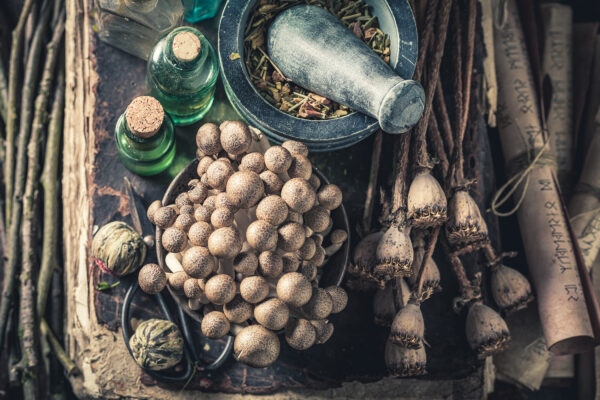How Supplements Work
By Joel Thuna
I have often been asked “how can one herb or vitamin or mineral have so many different actions?” Often these are asked with a sometimes not so subtle hint of scepticism. In a world where we are bombarded by messages about new drugs clinically proven to do one thing well, it makes sense that any therapeutic substance clinically proven well at doing multiple things is odd.
If you sit down and look at our bodies and their therapeutics (drugs, vitamins, minerals and herbs), paying close attention to how they actually work in our bodies, it starts to make sense. Remember that your body only has one source of inputs, the things that are put in it. They can get in either from your openings (nose, mouth, etc.) or through your skin. That is it. Your body must use the substances that get in through these limited pathways to get everything your body needs to function day in and day out.
With such a limited amount and variety of inputs, it only makes sense that your body would find multiple uses for each specific compound. Your body is a remarkable and insanely complex machine with a wide variety of interconnected systems that all rely on the same inputs. That is why, as an example, vitamins like B12, C, D and K2, minerals like calcium, magnesium and iron, fiber and protein are each used by virtually every body system. I picked these not because they are used more than others, but merely that they are some of the best known nutrients.
If you are deficient, or even slightly low in any of these, it can have multiple negative health effects. Take one of my current favourites, vitamin K2. This is an interesting vitamin as it once was relatively abundant in our diets and is now virtually non-existent. K2 plays an active role in your liver, lungs, kidneys, eyes, brain, heart, blood, stomach, colon, skin, arteries, bones, bladder, nails, joints, nerves, pancreas and more. Remember this is just one single nutrient.
Now when it comes to pharmaceutical drugs, this same multiple use effect happens. This is one reason why if you take drug A for problem Z, A may help with your problem BUT it may also cause side effects P, Q, R, S, T, U, and V. This is not only because the drug itself may interact with multiple systems beyond the one associated with condition Z, but the biological causes of condition Z may interact with other body systems. A prime example of this is heartburn. The most common drugs for heartburn cause Iron and B12 deficiency as well as increasing risk of bone fractures, pneumonia, and C. difficile infection.
Here is where the majority of natural products differ with pharmaceutical drugs. Pharmaceutical drugs are normally refined and concentrated to such a high degree that they are usually effective for one specific condition, but often at the cost of some serious side effects. On the other hand most natural products are either nutrients that our bodies are tuned to use or plants (herbs) that are minimally processed. Because of this their effects are less dramatic, but so is the risk of side effects.
What about isolates? These are the natural compounds from plants. For the most part these are similar to vitamins or minerals in that they are nutritional compounds that can have multiple uses in the body based on which body systems they affect. Take for example chlorophyll, the green pigment in plants. Every time you eat a green vegetable you are getting a minute, sub-therapeutic dose of chlorophyll. Now if you took a plant really high in chlorophyll, e.g., mulberry leaves or alfalfa sprouts, and extracted just the chlorophyll leaving behind everything else, then you would get a therapeutic dose. And just what can chlorophyll do for you? Stimulate your immune system, combat fungal infection, detoxify blood and the digestive system, prevent body and digestive odors, help you breathe, give you energy, create components of blood, reduce hunger, prevent weight gain, and prevent cancer to highlight a few. The downside to chlorophyll is that if you take too much, your urine and feces can change colour. This is because your body only takes what it needs, and eliminates the rest in the bathroom. But that is it. No nasty harsh effects.
What about herbs? Let’s pick another favourite of mine, Goldenseal. This one is native to Southern Ontario and used worldwide. Goldenseal was used by Indigenous peoples for immunity and in Eastern cultures as a digestive. This herb has undergone a fair bit of research. Scientists have identified 75 active compounds with 46 of them having known effects. Once again your body can use each compound for multiple activities. In the case of Goldenseal, these 46 compounds have 453 known activities affecting multiple organs. These activities include: anti-aging, Alzheimer’s prevention, antibacterial, antiviral, anticancer, digestive, bone building, cholesterol lowering, appetite suppression, anti-inflammatory, liver protecting, sugar balancing, weight loss and the list goes on.
The unique combination of specific vitamins, minerals, fibers, proteins, enzymes, fats, oils and phytonutrients at their specific ratios are what give each herb its unique set of actions. The herb’s abilities are not just based on the individual activities of each compound it contains but also on the interactions of compounds and their actions. This is why for many herbs the therapeutic dose changes based on what it is being used for.
Sometimes multiple actions make sense because they are connected. Horny goat weed, as an example, is used primarily for energy, strength, endurance, libido, erectile dysfunction and vaginal dryness. It increases circulation, testosterone production, and oestrogen levels in post-menopausal women. These are all connected with sexual health. With increased libido your body could really use increased energy and endurance. Once you add the actions of helping reduce erectile dysfunction and vaginal dryness, the result is a complete sexual health herbal package for both men and women. You may be wondering what other actions horny goat weed has, well, it helps build bones and reduce arteriosclerosis. Although these are not directly connected, sexual activity can put a strain on your bones and arteries, so boosting them is definitely a plus. The side benefit to horny goat weed is that a lot of athletes (both armchair and elite) use it with great results.
Your body is one of the most complex, interconnected machines that ever existed. To live a long healthy life you need to treat it with the respect it deserves and provide it with the inputs it needs to thrive. Pay attention to what goes inside you, and how it affects you and be on your way to feeling great!
Joel Thuna, MH, is a master herbalist with over 30 years of experience. www.globalbotanical.com




